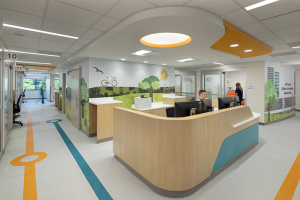International health care interior designs

View "Studying abroad" Gallery
Illness is universal, says Brooke Horan, IIDA, LEED AP, EDAC, senior interior designer in the San Francisco office of design firm HDR, who has worked overseas in Saudi Arabia, the United Arab Emirates and Korea. She says that regardless of location, every health care interior design project is focused on the comfort and safety of patients, their families and hospital staff. Efficient, high-quality design and long-term value are concerns everywhere, but how these goals are met can depend on regional differences. Quality of experience is in the details.
Quality experience
One thing Horan has noticed on international projects is how well the importance of family can be integrated into facilities. In areas where families tend to be larger and more involved, public spaces and patient rooms are generously sized to accommodate more people, she says.
You may also like |
| Design teams learn lessons from foreign projects |
| |
Cultural values also can affect the layout of the patient room. Placing the toilet room inboard in the room, for instance, creates a greater amount of space in the family zone, so large families can gather at the bedside without disrupting caregiver workflow. In addition, inboard placement is sensitive to feelings about modesty and privacy. The inboard location creates what some consider a welcome buffer between the bed and the corridor.
In the Middle East, levels of privacy are integrated into circulation and waiting areas, Horan says. Screens crafted from materials like glass and wood veil open areas to create multiple modes of privacy and engagement. Screen elements also provide an opportunity to express the local design vernacular, through the use of Islamic geometry. There is a recognition that these geometries are sacred, symbolizing the infinite nature of the universe, Horan explains.
Culturally based amenities include separate waiting areas designed for families (men, women and children) and men alone. Tea rooms within large waiting areas on the patient floors allow families to maintain a culture of hospitality when guests visit them at the hospital. Horan says prayer rooms also are provided on each patient floor and near public waiting areas to support the practice of prayer five times a day.
Horan says her experience on international projects has made her appreciate even more the details and sensitivity that go into health care interior design. She is conscious of helping people stay supported and connected throughout the experience of care. Through furnishings and settings that support technology, patients and guests have the ability to work and stay connected. “We always encourage clients to focus on the quality and variety of experience they’re providing,” she says.
With that in mind, Horan is looking beyond health care for new models of seating, such as those used in retail, hospitality and transportation markets. Bar-height tables with embedded power, soft benches and diner booths that enable two to four people to sit and face each other are unique, noninstitutional alternatives to tandem seating, she notes.
Horan says that working in other countries has emphasized the importance of connecting on a personal level in business relationships. It’s through building trust that clients understand “we have [their] best interests at heart and will deliver a facility we all can feel proud of and will meet [their] needs,” she says.
Local values
Ana Pinto-Alexander, EDAC, IIDA, HKS principal and global director for health care interiors, says that clients in different countries have different values and design criteria. Her work outside the United States has given her insight into infection control strategies, sustainable materials, diverse project delivery methods and a variety of care environments.
European countries are highly concerned with infection control, according to Pinto-Alexander. Designs for health facilities in this region of the world must accommodate stringent hand-hygiene methodology and utilize especially durable, cleanable materials. For example, cubicle curtains tend to be plainer in design as they are removed for cleaning each time a patient is released. Seamless, solid-surface materials are preferred over plastic laminate, and interior detailing tends to be simple but lovely, she says.
Sustainable materials, like rubber flooring, also are popular in Europe. “Sustainability is huge,” says Pinto-Alexander, explaining that European clients tend to be attentive to life-cycle costs, and are willing to pay more up front for long-lasting materials that require fewer resources to maintain. Energy controls for lighting are rigorous in the United Kingdom, she notes.
Pinto-Alexander says that providers in countries with socialized medicine have similar concerns about acoustics as those of their U.S. counterparts that are working in a competitive market. The difference is that the European Union and United Kingdom acoustical guidelines are regulated by the government. These guidelines recently have been amended to include on-site acoustic testing upon completion, so it is even more of a concern than it has been in the past, she adds.
A country’s labor force can determine materials and design characteristics. Vinyl flooring patterns, for example, tend to be simpler in China and India due to manufacturers’ installation requirements. Chinese construction, on the other hand, can be incredibly fast. “We built an eight-story hospital in 13 months. That’s unheard of,” Pinto-Alexander relates.
She says that private investors in India are trying to recruit doctors back from the United States with health care projects that include not just the hospital building, but a nearby residential neighborhood. Hotels are being built for medical tourists, and a range of patient environments are offered — from wards, in which design elements like headwalls and lighting are used to define each patient area, to semiprivate and private rooms.
In the Middle East, health facilities are “all about amenities,” says Pinto-Alexander. She notes, for example, labor and delivery suites that include a separate room for the father, a waiting area and even space for the family cook.
Despite regional differences in project scope and priorities, some things are constant in health care interior design: “Everyone’s aware of the budget,” she says. “[And] everybody wants to have access to natural light.”
World class
Because America is considered a world-class health care provider, architecture firms based in the United States are invited to participate in projects worldwide, says Karen Miller, IIDA, senior associate, NBBJ. Miller, who is based at the firm’s Columbus, Ohio, office, and her colleague Clark Pickett, LEED AP, senior associate in NBBJ’s London office, say international clients are especially interested in design’s relationship to the patient experience.
Pickett says the role of the patient experience in outcomes and as a differentiator among health care facilities is becoming universally understood. In his work in the United Kingdom, he’s noticed people beginning to look beyond strict efficiency to consider the importance of good interior design in lowering stress levels, enabling patients to rest and in speeding the healing process.
Miller says it’s fun and challenging to work with clients who are unfamiliar with, but receptive to, integrating interior design elements like graphics, furniture, art and lighting. Working with clinical staff to mock up room designs is also new in many areas, according to Pickett.
Understanding the colors of a region, its weather patterns and landscape is crucial to the design of any facility. These factors can affect design concepts and material selection. For a project in Dubai, for example, Miller chose a water motif for a clinic located on the Persian Gulf. In that locale, water is considered the foundation of luxury, she says. The clinic’s interior design celebrates how water moves, how it transmits color and light, and how it reflects the image of the sky.
Pickett describes a project in Scotland in which natural light and garden views were incorporated into the interior design throughout the building. This was to take advantage of daylight and express the natural seasons of the area.
He says it’s important to take the time to become attuned to cultural differences as well as differences in the physical environment. Subtle nuances can be meaningful. As an example, Miller says the color white is associated with mourning in some countries. She notes, too, that furnishings can be arranged so as not to catch on flowing clothing in areas where this is traditionally worn.
Informed design
Sensitivity to cultural norms is valuable “no matter who you’re designing for, in the United States or overseas,” says Pickett. Miller notes that U.S. urban areas, in particular, are becoming more diverse. “The demographics are changing every year. We’re a multicultural society,” she says. “We have to learn how to address first- and second-generation residents in our hospitals. They expect to be treated well.”
According to Miller, achieving cultural competency is a bit like learning a language. “You live in a country and over time you learn,” she says. It helps that designers, in general, tend to be “very curious people,” Pickett adds. “It’s part of our profession. It helps [to] inform design.”
“Working in health care domestically and internationally — it’s about helping people help people,” Miller says. “That’s what gives meaning to the work.”




